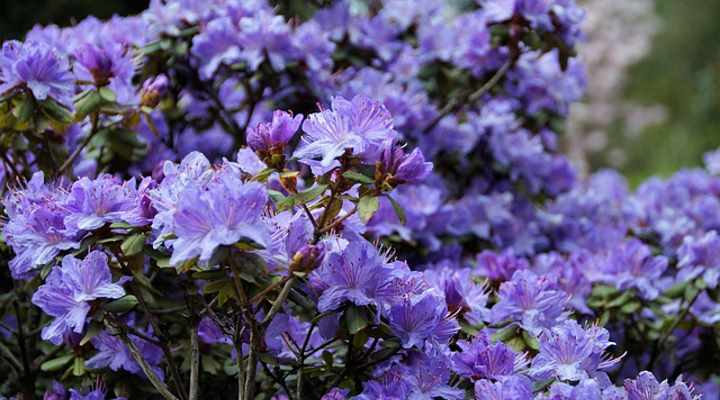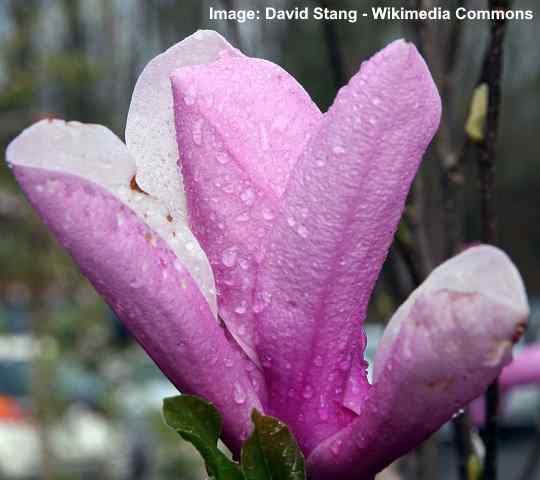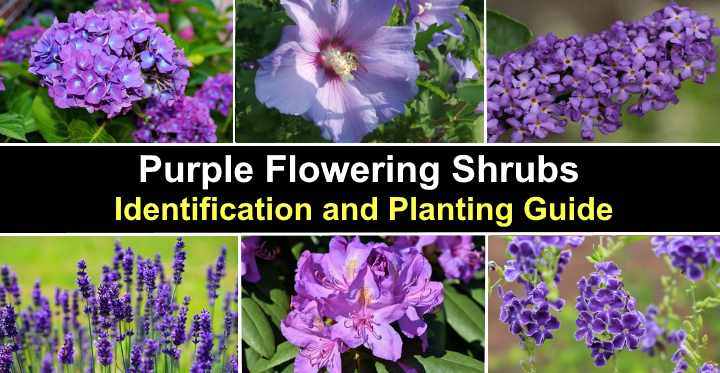Purple flowering shrubs are a wonderful addition to your landscape, adding beautiful colors. Shrubs with purple flowers may be enhanced with lilac, lavender, plum, violet, and mauve hues. At full bloom, the bright purple blooms contrast beautifully with the lush green foliage, producing striking color contrasts. By growing perennial blooming bushes, you can get flowers that bloom year after year. Evergreen flowering shrubs in your garden can provide color year-round.
It is simple to grow purple blooming shrubs in your front or back garden. Your growing zone, hours of daily sunlight, and soil type should all be taken into consideration when selecting blossoming bushes. Moreover, to save time on gardening, choose low-maintenance shrubs. By doing this, you may save time spent pruning, fertilizing, and watering the bushy plants while still seeing purple flowers and lovely aromas.
Many purple landscape plants are relatively compact and thrive in containers, even if you don’t have a huge yard to fill with big flower bushes. Dwarf purple blossoming shrubs, for example, may embellish a patio, deck, entryway, or pot garden when cultivated in pots. The finest purple landscape shrubs, bushes, and plants for your garden are covered in this article. Moreover, photographs of purple blooming bushes may help you identify suitable plants for your garden.
How to Choose the Best Shrubs with Purple Flowers
There are a number of factors to consider when selecting the finest flowering shrubs for your garden. Location is the most important factor. Hedges, foundation plants, along borders, and at the back of a flower bed may all be made up of flowering evergreen and perennial shrubs. It’s also important to think about how much sunlight or shade the plant receives.
Your temperature zone is one of the most important things to consider when growing flowering shrubs. USDA zones 5 through 9 are ideal for many perennial flowering plants. In temperate areas, you may also cultivate rhododendrons, lilacs, roses of Sharon, wisteria, and butterfly bushes. Purple plants, such as fuchsias, bougainvillea, and golden dewdrops, need warm temperatures to flourish outside.
Purple Flowering Shrubs (Pictures and Descriptions) – Identification
Let’s take a closer look at gorgeous flowering bushes that bloom from spring through fall, giving your garden a purple hue.
Purple Hydrangea Shrubs (Hydrangea macrophylla)

Hydrangeas, which include magnificent purple blooms, are massive deciduous shrubs that provide a stunning focal point in the front of the garden. The huge globe-like bluish-purple blooms, which are composed of little five-petaled flowers, distinguish purple hydrangea bushes. The massive purple flowerheads may be up to 14 inches (35 cm) broad, depending on the kind of hydrangea.
Bigleaf hydrangeas, smooth hydrangeas, panicle hydrangeas, and oakleaf hydrangeas are some of the many kinds of flowering hydrangea bushes. The bigleaf Hydrangea macrophylla variety is the most common kind of purple hydrangea bush. In zones 5 to 9, these blossoming trees thrive. The flowering perennials will bloom continuously throughout the summer and into the autumn under the right circumstances.
Purple Fuchsia Shrubs

Fuchsia is a popular garden plant for its colorful purple, pink, and red flowers. It is a low-growing shrub with attractive blossoms in various hues. Fuchsia bushes produce lovely drooping blooms with a purple gaping hole in the middle called a corolla and surrounding brilliant red or pink petals. They grow up to 2 feet (0.6 meters) tall. Planting purple blooming fuchsia bushes in mixed borders, along walls, or in pots is a great idea.
The showy red and purple floral display is made up of the attractive arching branches’ numerous pendulous flowers. In USDA zones 8 through 11, fuchsia bushes may be grown in the ground. Hardy flowers, on the other hand, are cold hardy to zone 6. Fuchsia plants should be planted in shady areas or in the shade of morning and afternoon sun.
Purple Flowering Rhododendron Shrubs

For a small garden, you may pick dwarf purple rhododendron blooming shrubs. The frilled petals of the funnel-shaped purple blooms grow up to 4 inches (10 cm) wide. The trumpet-shaped blooms produce a lovely fragrance when they are in bloom. USDA zones 5 through 9 are optimal for these hardy flowering bushes, although there is variation among varieties.
Rhododendrons grow in well-drained soils and flourish in full sun or partial shade. Choose from the compact, purple-flowering dwarf rhododendrons that grow between 3 and 6 feet (1 and 2 meters) tall and wide if the large rhododendron shrubs are too big for your yard. Rhododendrons are beautiful front-of-house plants and colorful foundation plants that may be pruned properly.
Azalea

In well-drained soil, purple flowering azalea shrubs thrive in full sun or partial shade. Deep purple flowers last the entire summer on some types of evergreen azaleas. Flowers return year after year in certain deciduous purple azaleas. Depending on the species, azaleas thrive in full sun to partial shade and grow between 3 and 8 feet (1 to 2.4 meters).
The Formosa azalea, also known as the Autumn Lilac, April Rose, and Satsuki evergreen azaleas, are among the purple-flowering azaleas available. As a flowering hedge, you can also grow purple rhododendron and azalea bushes. Privacy screens, living fences, and security hedges are all good applications for evergreen plants with dense growth. The leafy green leaves seem to come alive with lilac, purple, and violet hues from late spring through the summer.
Bluebeard (Caryopteris x clandonensis)

Bluebeard is a tiny flowering deciduous shrub with silvery-green leaves and little blue-purple blooms on upright stems that adds a beautiful touch to a front yard. This 2 to 3 ft. (0.6 to 1 m) tall low-growing, clump-forming shrub In late summer and early autumn, purple blooms bring a lovely fragrance to the garden.
USDA zones 6 through 9 are the ideal conditions for Bluebeard shrubs. The sun-loving plant should be placed in well-drained soil. The purple shrub is a great low-maintenance plant for front gardens, perennial borders, butterfly gardens, and pots because it is fairly drought tolerant.
Butterfly Bush (Buddleja)

The butterfly bush is distinguished by its beautiful purple, pink, and white blossoms, as well as yellow and orange blossoms. The flowers last until frost and bloom in mid-summer for purple perennials shrubs. The rounded shrub is covered in masses of gorgeous lilac-colored blooms that attract butterflies and emit lovely scents. The bushy butterfly bushes are approximately 5 to 10 feet (1.5 to 3 meters) tall.
A dwarf variety of butterfly bushes is a good option for a compact garden. Showy conical purple flowers adorn the lovely blooming shrubs. Foundation planting, container growing, cottage gardens, and perennial borders are all ideal applications for all types of butterfly bushes.
Lavender (Lavandula spp.)

Purple lavender plants, which are very popular all across the globe, are especially stunning when planted in huge numbers. Violets, lilacs, light blues, and dark purples are among the hues of the tall blooming spiked clusters. The woody shrub-like perennial, sometimes known as common lavender, grows in clusters and may reach 2 to 3 feet (0.6 to 1 meters) tall. In USDA zones 5 through 9, purple lavender bushes thrive.
They’re easy-care perennial blooming shrubs that thrive in full sun and well-drained soil. There are varieties with white-flowering lavender (Lavandula angustifolia ‘Nana Alba’) and lavender with pink flowers (Lavandula angustifolia ‘Rosea’), in addition to the most popular purple-flowering varieties.
Lilac Shrubs (Syringa vulgaris)

Lilac bushes produce clusters of purple, violet, lavender, rose, magenta, and lilac-colored blooms that are cone-shaped. The large cone-like flower clusters (panicles) produce a strong fragrance and may grow up to 8 inches (20 cm) long. In late spring, Lilac blooms for up to four weeks. Lilac shrubs bloom at an height of 8 to 15 feet (2.4 to 4.5 meters) tall and broad.
You can, however, grow dwarf lilacs that don’t exceed 4 feet (1.2 meters) in height for smaller yards. Lilac shrubs are cold-hardy in zone 3 and can be grown in practically any soil. In the summer, you may grow lilac hedgerows, specimen plants, or screens for privacy.
Clematis

Planting your purple clematis shrub in full sun is the most effective way to boost flower production. Like the climbing types, herbaceous clematis has flowers and leaves that form clump-like clusters. In the summer and fall, four or five curving purple or blue petals appear on the bell-shaped drooping flowers.
Clematis shrubs that are not climbers typically grow to be only 1 to 8 feet (0.6 to 2.5 meters) tall and 3 to 3 feet (1 meter) broad. Late in the autumn, the woodier bushes drop their leaves, and in the spring, they remerge to bloom. Clematis planted in full sun produces a constant supply of lovely flowers.
Purple Flowering Jane Magnolia (Magnolia liliiflora x Magnolia stellata)

The purple blooming flower jambhalia may be a huge shrub or small tree, depending on the variety. The showy, cup-shaped fragrant flowers of the Jane magnolia are a slow-growing purple flowering shrub or small tree. The flowers of the magnolia shrub are purple-pink and may reach 8 inches (20 cm) in diameter. 6-inch (15-cm) long, ovate glossy green leaves make up the landscaping shrub’s foliage.
Between 10 and 15 feet (3 and 4.5 meters) tall, the compact Jane magnolia bush thrives. USDA zones 4 – 8 in full sun to part shade are ideal for purple blooming Jane magnolia. The Magnolia liliiflora and Magnolia stellata hybrids dubbed “The Little Girl Series” include the Jane magnolia, which has purplish-red blooms.
Golden Dewdrops (Duranta erecta)

In warm weather and full sun, golden dewdrops thrives as a purple-flowered shrub. Five purple petals with white borders make up the star-shaped purple flowers. The sweet vanilla-like odor of the loose hanging panicles on arching stems can reach 6 inches (15 cm) in length. Golden dewdrops are an evergreen decorative shrub that thrives in subtropical climates.
Only zones 10 and 11 are cold-hardy, though. As a result, you’ll need to grow this stunning shrub in a pot and overwinter it indoors or outdoors in temperate areas. As a cautionary note, brightly colored orange berries emerge after the purple blooms have faded. The berries are very dangerous to people and animals, but birds consume them.
Evergreen Purple Flowering Bougainvillea Shrub

Bougainvillea is a spreading shrub or climbing plant that produces masses of purple, magenta, or pink flower-like bracts throughout the summer. It comes in several hues and thrives in full sun. Little white blooms make up the flowers on a bougainvillea bush. The showy bracts that surround the blooms give the plant its vibrant color.
In the southern states, flowering evergreen bougainvillea bushes are plentiful. In addition, Florida gardens, California gardens, South Carolina gardens, and Mediterranean countries are adorned with showy colorful bushes. Bougainvillea grows between 3 and 40 feet (1 and 12 meters) tall and is a scrambling shrub. When grown in zones 9 and 10, the papery red, white, pink, or purple blooms bloom throughout the summer.
Purple Crape Myrtle Bushes (Lagerstroemia indica)

Crape myrtle is a lovely blooming shrub with huge purple showy flowers, a wide spreading crown, and appealing leaves that begin to bloom in late summer. Cinnamon-colored bark and vivid orange-red fall leaves are other characteristics of the crape myrtle shrub. Late summer sees the emergence of purple flower clusters, which last till late autumn. Crape myrtle shrubs come in a variety of shapes and sizes.
Dwarf shrubs may grow up to 4 feet (1.2 meters) tall, while larger shrubs might grow up to 15 feet (4.5 meters) tall and broad. Catawba Crape Myrtle (Lagerstroemia indica ‘Catawba’), ‘Early Bird Purple,’ ‘Early Bird Lavender,’ and ‘Purple Magic’ are examples of purple-flowered crape myrtle shrubs.
Rose of Sharon (Hibiscus syriacus)

Rose of Sharon is a hardy hibiscus shrub with showy trumpet-shaped pale purple flowers and a deep purple throat. It is a variety of Hibiscus syriacus. Ruffled petals, a huge projecting stamen, and a pleasant fragrance characterize the five-petaled blooms. Sharon shrub roses may grow up to 10 feet (3 meters) tall and 8 to 12 feet (2.4 – 3.6 meters) broad.
USDA zones 5 through 8 have a rose of Sharon shrub that thrives in full sun to partial shade. The deciduous perennial thrives in abundance of sunlight and creates profusion of vivid blooms. Light purple or pink blooms may be solitary or double, and they last for a long period of time depending on the species. As a foundation planting, summer hedge, or shrub border, plant a rose of Sharon shrubs. You may also develop a magnificent hibiscus tree with the necessary trimming and training.
Wisteria

Wisteria is a flowering vine that may climb arbors or pergolas, with gorgeous purple blossoms. On drooping clusters of fragrant blooming flowers, masses of white, pink, and purple blooms appear. A wisteria plant’s eye-catching decorative blooms may grow up to 18″ (45 cm) long. Wisteria grows 10 to 25 feet (3.7 to 7.6 meters) tall as a blooming vine.
You can grow the woody vining plant as a small shrub-like tree to enjoy purple wisteria flowers. Suckers that appear should be pruned, and the central stem should be staked for support. A tiny flowering shrub around 6 feet (1.8 meters) tall and breadth will grow over time. Wisteria may alternatively be grown as a container hedge to enjoy the lavender or purple flower clusters.
Purple Rose Shrub

There are several cultivars of purple-flowering rose shrubs to choose from, each suited to a particular garden. One of the most gorgeous flowers for your garden is Shrub Roses. Rose bushes develop deep plum-purple, pale lilac, and pinkish-purple blooms that reach 4 to 6 feet (1.2 – 1.8 meters) in height. Purple shrub roses have a bushy, bush-like growth in most varieties. Open blooms with five petals or frilly blooms with multiple fluffier blooms may be found among the purple blooms.
Winter Heath (Erica x darleyensis)

TWinter heath is a tiny woody shrub with clusters of urn-shaped pinkish-purple or pink-lilac flowers that is planted during the winter. The thin needle-like evergreen leaves growing on upright stems distinguish the bushy heath shrubs, which grow to be 18 inches (45 cm) tall.
The dark green leaves contrast with the tiny light purple or black pink bell flowers that grow along the length of the stem. Winter heath is a late-winter to early-spring blooming decorative plant that flowers throughout winter. The snow contrasts with the spectacular evergreen foliage and light purple or pink blooms, bringing color to a bleak environment.
Heather (Calluna vulgaris)

Heather is a low-growing purple blooming shrub that may be cultivated in both full sun and partial shade. It can be cultivated in both light and dark conditions. At the end of upright woody stalks, decorative blooms bloom as racemes. Heather blooms in late summer and autumn, unlike the related winter heath. Heather grows to be 8 to 20 inches (20 to 50 cm) tall.
When in bloom, the cold-hardy wild shrub creates gorgeous purple hues in the landscape. Moreover, in cold weather, some ornamental types of heather have lovely crimson or gold leaves that are more vivid. For year-long evergreen foliage and light purple summer and fall blooms, grow heather in pots or along borders.
Russian Sage (Salvia yangii)

Russian sage is a tiny herbaceous shrub with upward-growing thin stems covered in lavender-blue blooms that is one of the best purple blooming hardy and drought tolerant plants to landscape your yard. From mid-summer till late autumn, the blue to violet blossoms bloom. In summer landscapes, the spray of airy stems produces a hazy, pale purple effect. When crushed, the aromatic leaves have a sage-like fragrance.
The Russian sage grows to be about 1.6 to 4 feet (0.5 to 1.2 meters) tall. In shrub borders, along driveways, and in containers, Russian sage is ideal as a deciduous perennial. Furthermore, despite drought, the flowering shrub’s purple lavender blossoms last longer, making it ideal for Xeriscaping.
